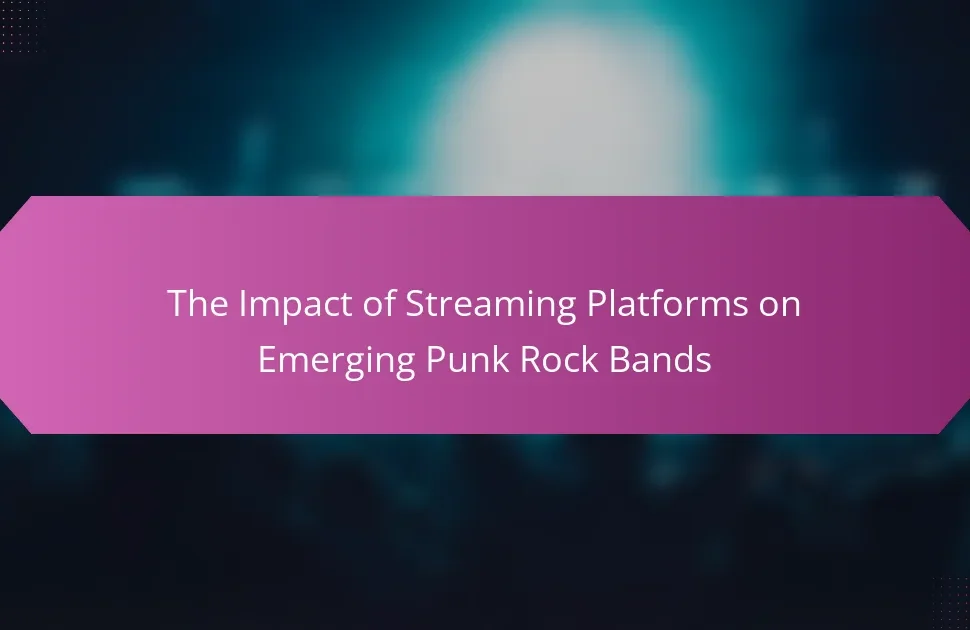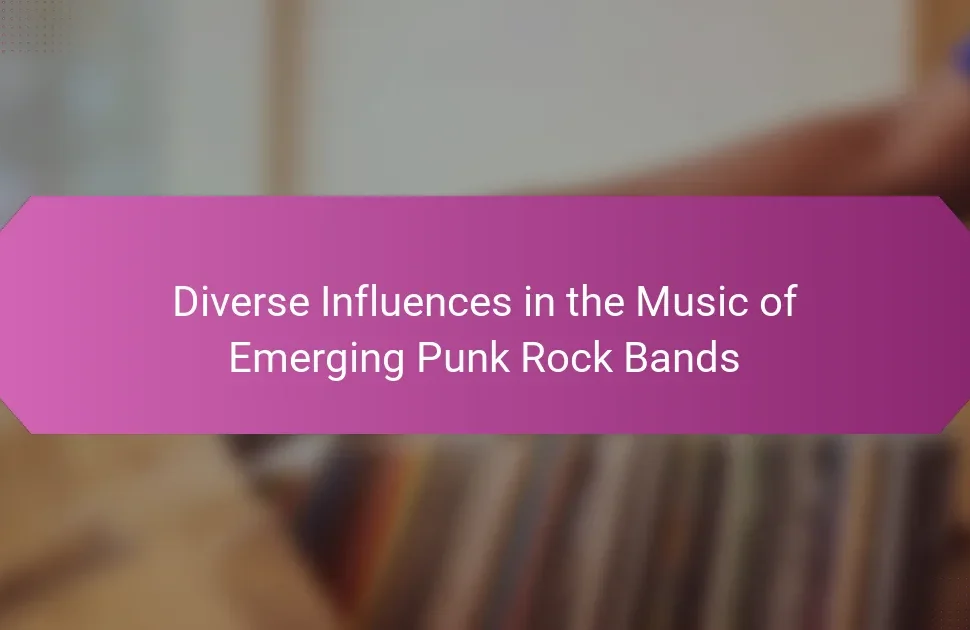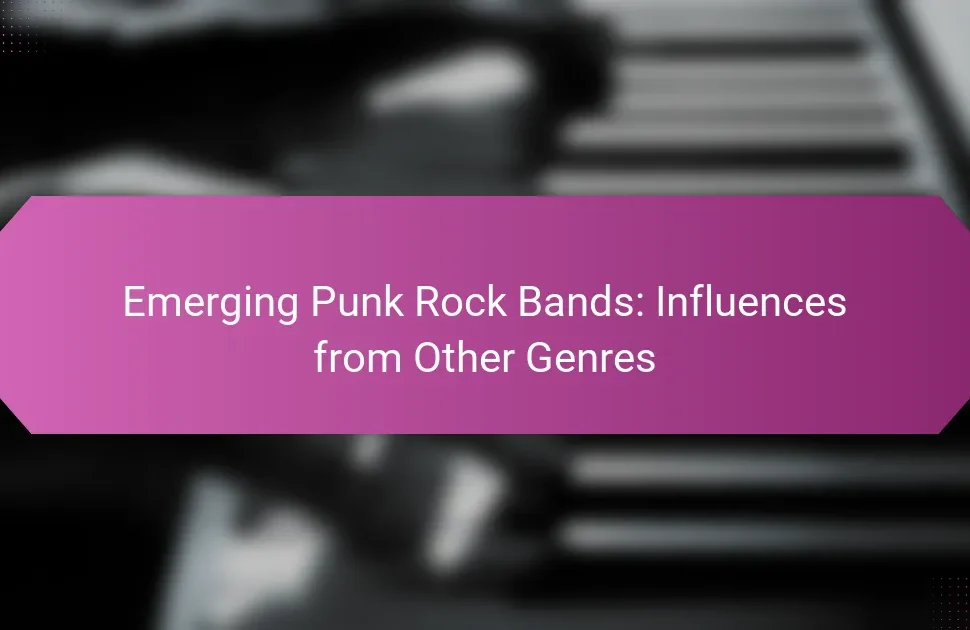Emerging punk rock bands showcase regional variations that reflect local culture and socio-political contexts. North American bands often blend traditional punk with pop and hip-hop elements. European acts maintain a raw, political edge, while Latin American groups incorporate indigenous rhythms. Asian punk scenes frequently mix traditional sounds with punk, creating vibrant fusions that enhance the global landscape.

What are the defining characteristics of emerging punk rock bands?
Emerging punk rock bands exhibit distinct regional characteristics influenced by local culture, socio-political contexts, and musical heritage. For example, bands from the UK often emphasize political themes, while American counterparts may focus on personal narratives.
In Latin America, punk rock often reflects social struggles and activism, showcasing unique instrumentation and rhythms. Asian punk bands frequently blend traditional sounds with punk elements, creating a hybrid genre that resonates with local audiences.
These regional variations contribute to a rich tapestry of punk rock, highlighting each area’s unique attributes while maintaining the genre’s rebellious spirit.
How do cultural influences shape punk rock music styles?
Cultural influences significantly shape punk rock music styles through regional variations. Different cultural backgrounds lead to unique expressions in lyrics, instrumentation, and performance styles. For example, Latin American punk often incorporates local rhythms, while Japanese punk may reflect distinct societal themes. These variations highlight punk’s adaptability and its role in expressing local identities. Additionally, historical contexts, such as political movements, further influence the sound and message of emerging punk bands globally.
What role do local music scenes play in the development of punk rock bands?
Local music scenes significantly influence the development of punk rock bands by fostering community, collaboration, and unique sounds. These scenes provide a platform for emerging bands to connect with local audiences and other musicians.
Regional variations contribute to the distinctiveness of punk rock bands worldwide. For instance, bands in the UK often reflect socio-political themes, while American bands might emphasize individualism and rebellion.
Local venues and festivals serve as essential hubs for networking and exposure. They allow bands to perform live, receive immediate feedback, and build a loyal fan base.
Moreover, the diversity of local influences shapes the genre’s evolution. Bands often incorporate regional musical styles, leading to unique sounds that differentiate them from their peers.

Which regions are currently leading in the emergence of new punk rock bands?
Regions currently leading in the emergence of new punk rock bands include North America, Europe, and parts of Asia. North America remains a hub, particularly cities like Los Angeles and New York, known for vibrant punk scenes. Europe showcases emerging talent in the UK, Germany, and Scandinavia, where festivals and local venues foster new bands. Asian cities, such as Tokyo and Seoul, are gaining recognition for their unique interpretations of punk rock, contributing to a diverse global landscape.
How does North American punk rock differ from European punk rock?
North American punk rock emphasizes individualism and diverse influences, while European punk rock often reflects political themes and social commentary. North American bands like Green Day and The Offspring focus on catchy melodies and mainstream appeal. In contrast, European bands such as The Clash and Crass prioritize a raw sound and ideological messages. The cultural contexts also shape their lyrical themes and performance styles, with North American punk being more commercially viable and European punk often maintaining a more underground ethos.
What unique sounds are emerging from Asian punk rock bands?
Emerging Asian punk rock bands are creating unique sounds by blending traditional music elements with punk influences. For instance, bands from Japan often incorporate anime themes, while those from Indonesia mix local rhythms and instruments. This fusion creates a distinctive auditory experience that reflects cultural identities. Additionally, the DIY ethos prevalent in punk is evident, with many bands self-producing music that emphasizes authenticity and grassroots connections. Such regional variations highlight the diverse landscape of punk rock in Asia, showcasing a rich tapestry of sounds influenced by local cultures and global punk traditions.
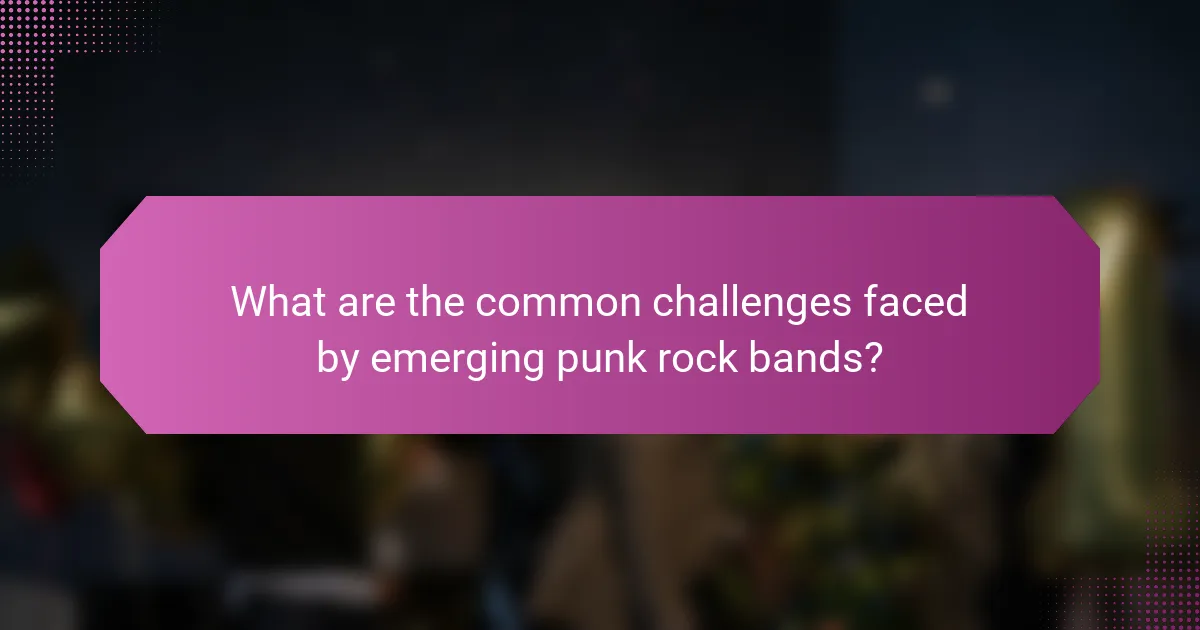
What are the common challenges faced by emerging punk rock bands?
Emerging punk rock bands face several common challenges, influenced by regional variations. These challenges include limited access to venues, varying audience sizes, competition from established genres, and differing cultural perceptions of punk.
In regions with fewer punk scenes, bands struggle to find performance spaces, which affects their visibility. In contrast, areas with a vibrant punk culture may have a saturated market, making it difficult for new bands to stand out. Additionally, financial constraints often limit promotional efforts and recording opportunities, impacting their growth and reach.
Cultural attitudes towards punk can also vary significantly. In some regions, punk is embraced as a form of rebellion, while in others, it may be viewed with skepticism, hindering acceptance and support for emerging bands.
How do financial constraints affect the growth of new punk rock bands?
Financial constraints significantly hinder the growth of new punk rock bands by limiting resources for promotion and touring. Bands in regions with fewer financial opportunities struggle to access essential tools for success, such as recording equipment and marketing. For instance, emerging punk bands in economically disadvantaged areas may have reduced access to venues, impacting their visibility and audience reach. Moreover, financial limitations can restrict collaboration with established artists, which often provides valuable exposure and mentorship. As a result, regional variations in financial support contribute to disparities in the development and recognition of punk rock bands worldwide.
What impact does digital streaming have on the visibility of emerging punk rock bands?
Digital streaming significantly boosts the visibility of emerging punk rock bands by providing global access to their music. Bands can reach wider audiences without traditional barriers. Streaming platforms allow for regional variations, showcasing diverse punk rock styles worldwide. As a result, bands from different areas gain recognition and connect with fans across borders. This democratization of music distribution enhances their chances of success in a competitive landscape.
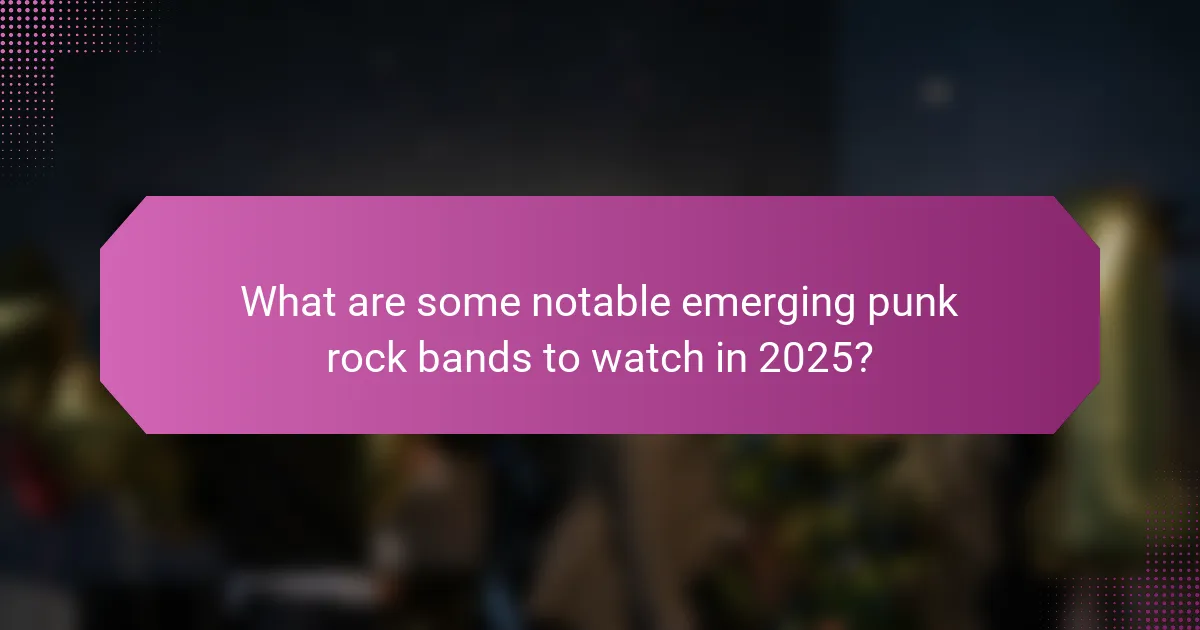
What are some notable emerging punk rock bands to watch in 2025?
Several notable emerging punk rock bands to watch in 2025 showcase regional variations that enrich the genre. From the UK, bands like “The Vexed” are gaining attention for their raw sound and socio-political lyrics. In the US, “Youth Brigade” brings a fresh take with their blend of classic punk and modern influences. South America features “Los Muertos,” who infuse local culture into their music, creating a unique punk experience. The Asian punk scene is represented by “Tokyo Scum Brigade,” known for their energetic performances and innovative style. Each band reflects distinct cultural influences, contributing to the global punk rock landscape.
Which bands are gaining traction in the North American punk scene?
Several bands are gaining traction in the North American punk scene, including Turnstile, Amigo the Devil, and Scowl. Turnstile blends hardcore punk with melodic elements, attracting a diverse audience. Amigo the Devil offers a unique fusion of folk and punk, while Scowl’s aggressive sound resonates with traditional punk fans. These bands exemplify the evolving landscape of punk rock, highlighting regional variations and fresh influences.
What are the standout features of popular European punk rock bands?
Popular European punk rock bands are known for their raw energy, political themes, and diverse sounds. Key features include a strong DIY ethic, blending of musical styles, and regional influences. For instance, British bands often emphasize socio-political commentary, while Scandinavian groups may incorporate melodic elements. Additionally, the emergence of female-fronted bands highlights a shift towards inclusivity in the genre. Unique attributes, such as the fusion of local cultural elements, differentiate these bands within the global punk scene.
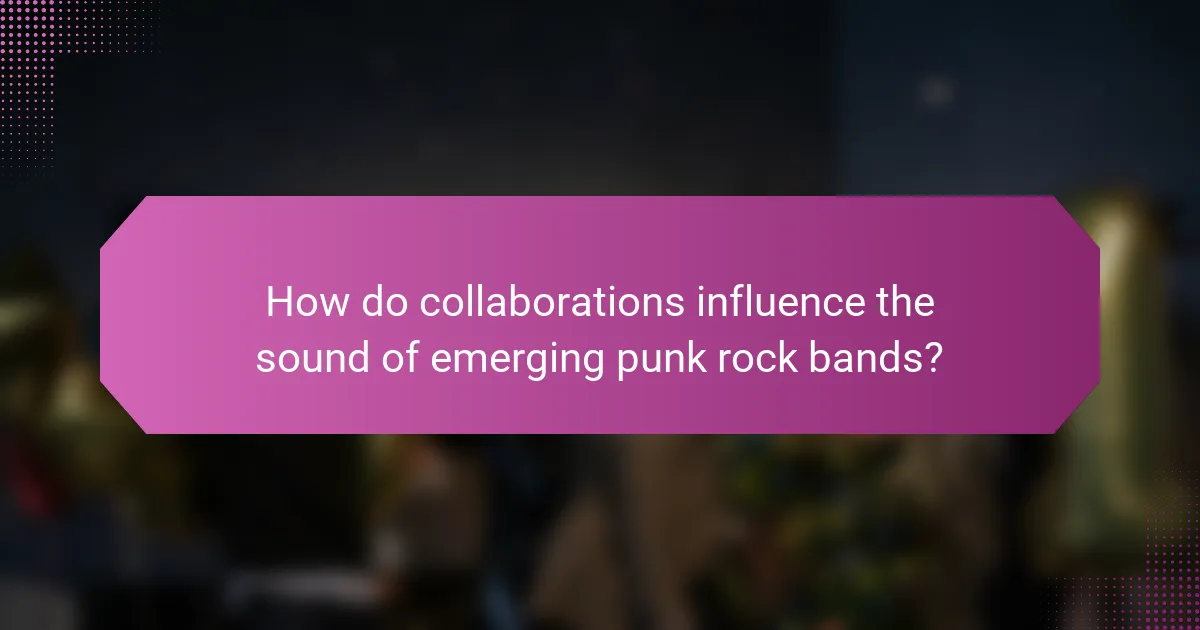
How do collaborations influence the sound of emerging punk rock bands?
Collaborations significantly shape the sound of emerging punk rock bands by blending diverse regional influences. These partnerships introduce unique musical styles and cultural elements, enhancing creativity. For instance, a band from the UK may collaborate with a group from South America, resulting in a fusion of traditional punk with local rhythms. This cross-pollination leads to distinctive sounds that reflect both the punk ethos and regional characteristics. Emerging bands often leverage collaborations to access new audiences, further diversifying their musical approach. Ultimately, these interactions foster innovation and variation within the global punk rock scene.
Which artists are known for cross-genre collaborations in punk rock?
Artists known for cross-genre collaborations in punk rock include Billie Joe Armstrong, who partnered with pop artist Norah Jones, and the punk band Rancid, which has worked with reggae artists like Jimmy Cliff. Additionally, collaborations between punk and hip-hop artists, such as the work of Anti-Flag with rappers, highlight the genre’s versatility. These partnerships enrich punk rock by blending diverse musical influences, showcasing its adaptability across regional variations.
What benefits do emerging bands gain from collaborations with established artists?
Emerging punk rock bands gain exposure, credibility, and networking opportunities through collaborations with established artists. These partnerships can enhance their visibility in the music scene and attract a broader audience.
Collaborating with well-known artists allows emerging bands to tap into established fan bases, which can lead to increased streaming numbers and ticket sales. Additionally, such collaborations often provide valuable mentorship, helping new artists refine their sound and gain insights into the industry.
Emerging bands may also benefit from the artistic growth that comes from working with seasoned musicians. This experience can lead to unique musical fusions, enriching the punk rock genre and showcasing regional variations in style and sound.
Overall, collaborations with established artists serve as a catalyst for growth, creativity, and recognition for emerging punk rock bands worldwide.

What are the future trends for emerging punk rock bands?
Emerging punk rock bands exhibit distinct regional variations influenced by cultural and social contexts. In North America, bands often blend traditional punk with elements of pop and hip-hop, creating diverse sounds. European bands, especially from the UK, maintain a raw, political edge, reflecting local issues. In Latin America, punk incorporates indigenous rhythms, showcasing unique cultural narratives. Asian punk scenes, particularly in Japan, often mix punk with visual kei and other genres, creating a vibrant fusion. These regional traits highlight the evolving nature of punk rock globally.
How are social media and technology shaping the next generation of punk rock?
Social media and technology are significantly influencing the evolution of punk rock by fostering diverse regional expressions. Emerging punk rock bands worldwide leverage platforms like Instagram and TikTok to share their music and connect with audiences.
In regions like Southeast Asia, bands incorporate local musical traditions into their punk sound, creating unique fusions. For example, Indonesian punk bands often blend traditional gamelan elements with punk rock, showcasing a rare attribute of cultural integration.
In Europe, the accessibility of digital tools enables bands to produce high-quality recordings independently. This democratization of music production allows for a wider array of voices and styles, reflecting regional issues and experiences.
As a result, the next generation of punk rock is more varied than ever, with each region contributing its own unique influences and perspectives, shaping a global punk identity.
What are the potential impacts of global events on the punk rock genre?
Global events significantly influence regional variations in the punk rock genre. Emerging punk rock bands worldwide respond to social, political, and economic changes, shaping their sound and message.
In regions experiencing political unrest, bands often adopt a more aggressive and confrontational style. For example, in Eastern Europe, bands reflect anti-establishment sentiments through their lyrics and performances.
Conversely, in more stable regions, punk rock may focus on personal or cultural themes. Bands in countries like Japan or Canada often blend traditional elements with punk, creating unique subgenres.
Furthermore, global events like the COVID-19 pandemic have led to increased collaboration among bands across borders, fostering a sense of unity. This has resulted in innovative sounds and cross-cultural influences that diversify the genre.
What best practices can emerging punk rock bands adopt for success?
Emerging punk rock bands can adopt several best practices for success. Focus on building a unique sound that reflects regional influences. Engage with local music scenes to foster connections. Utilize social media for promotion and audience engagement. Collaborate with other artists to expand reach. Prioritize live performances to build a loyal fan base.

